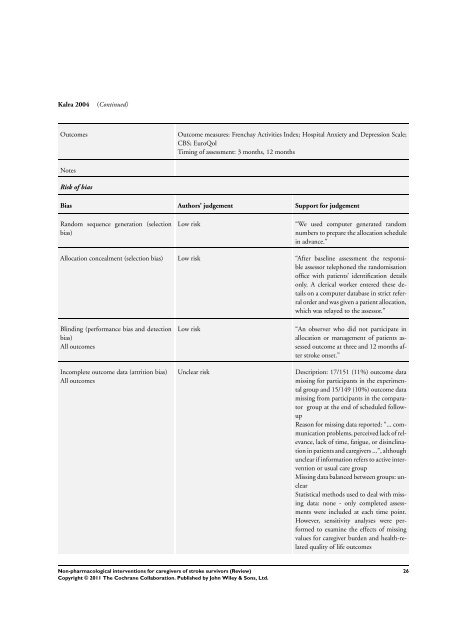Non-pharmacological interventions for caregivers ... - Update Software
Non-pharmacological interventions for caregivers ... - Update Software
Non-pharmacological interventions for caregivers ... - Update Software
You also want an ePaper? Increase the reach of your titles
YUMPU automatically turns print PDFs into web optimized ePapers that Google loves.
Kalra 2004 (Continued)<br />
Outcomes Outcome measures: Frenchay Activities Index; Hospital Anxiety and Depression Scale;<br />
CBS; EuroQol<br />
Timing of assessment: 3 months, 12 months<br />
Notes<br />
Risk of bias<br />
Bias Authors’ judgement Support <strong>for</strong> judgement<br />
Random sequence generation (selection<br />
bias)<br />
Low risk “We used computer generated random<br />
numbers to prepare the allocation schedule<br />
in advance.”<br />
Allocation concealment (selection bias) Low risk “After baseline assessment the responsible<br />
assessor telephoned the randomisation<br />
office with patients’ identification details<br />
only. A clerical worker entered these details<br />
on a computer database in strict referral<br />
order and was given a patient allocation,<br />
which was relayed to the assessor.”<br />
Blinding (per<strong>for</strong>mance bias and detection<br />
bias)<br />
All outcomes<br />
Incomplete outcome data (attrition bias)<br />
All outcomes<br />
<strong>Non</strong>-<strong>pharmacological</strong> <strong>interventions</strong> <strong>for</strong> <strong>caregivers</strong> of stroke survivors (Review)<br />
Copyright © 2011 The Cochrane Collaboration. Published by John Wiley & Sons, Ltd.<br />
Low risk “An observer who did not participate in<br />
allocation or management of patients assessed<br />
outcome at three and 12 months after<br />
stroke onset.”<br />
Unclear risk Description: 17/151 (11%) outcome data<br />
missing <strong>for</strong> participants in the experimental<br />
group and 15/149 (10%) outcome data<br />
missing from participants in the comparator<br />
group at the end of scheduled followup<br />
Reason <strong>for</strong> missing data reported: “... communication<br />
problems, perceived lack of relevance,<br />
lack of time, fatigue, or disinclination<br />
in patients and <strong>caregivers</strong> ...”, although<br />
unclear if in<strong>for</strong>mation refers to active intervention<br />
or usual care group<br />
Missing data balanced between groups: unclear<br />
Statistical methods used to deal with missing<br />
data: none - only completed assessments<br />
were included at each time point.<br />
However, sensitivity analyses were per<strong>for</strong>med<br />
to examine the effects of missing<br />
values <strong>for</strong> caregiver burden and health-related<br />
quality of life outcomes<br />
26












